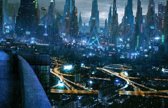

How to recognize a dystopia - Alex Gendler. Why should you read "The Handmaid's Tale"? - Naomi R. Mercer. And how your data could power it. Do Robots Deserve Rights? What if Machines Become Conscious? Microsoft : « Aujourd’hui, la technologie est utilisée pour s’attaquer à la démocratie » A Selfish Argument for Making the World a Better Place – Egoistic Altruism. Is the world getting better or worse? A look at the numbers. Yuval Noah Harari on Why Technology Favors Tyranny. Editor’s Note: This article is part of a series that attempts to answer the question: Is democracy dying?
I. The Growing Fear of Irrelevance There is nothing inevitable about democracy. For all the success that democracies have had over the past century or more, they are blips in history. Monarchies, oligarchies, and other forms of authoritarian rule have been far more common modes of human governance. The emergence of liberal democracies is associated with ideals of liberty and equality that may seem self-evident and irreversible. In the second decade of the 21st century, liberalism has begun to lose credibility. Information technology is continuing to leap forward; biotechnology is beginning to provide a window into our inner lives—our emotions, thoughts, and choices. Ordinary people may not understand artificial intelligence and biotechnology in any detail, but they can sense that the future is passing them by.
In 2018 the common person feels increasingly irrelevant. II. III. IV. I. The Virus That Kills Drug-Resistant Superbugs. The Future of Medicine. Soon We'll Cure Diseases With a Cell, Not a Pill. The future of medicine is inside these chips. The Top 10 Most Promising Medical Technologies UPDATED - The Medical Futurist. Niels van Namen: Why the hospital of the future will be your own home.
Genetic Engineering Will Change Everything Forever – CRISPR. How to Cure Aging – During Your Lifetime? Why Age? Should We End Aging Forever? Comment l'Intelligence artificielle révolutionnera-t-elle la santé? Andrew McAfee: What will future jobs look like? The last job on Earth: imagining a fully automated world.
La technologie détruit-elle l'emploi ? L’intelligence artificielle va-t-elle détruire des emplois ? Daniel Susskind: 3 myths about the future of work (and why they're not true) Universal Basic Income Explained – Free Money for Everybody? UBI. La faim du travail #DATAGUEULE 62. Then and Now: Reimagining Africa’s Future. Serons-nous un jour remplacés par des intelligences artificielles ? Why it's time for 'Doughnut Economics' Martin Ford: How we'll earn money in a future without jobs. Dessine-moi l'éco : Le revenu universel. Why is NASA sending a spacecraft to a metal world? - Linda T. Elkins-Tanton.
InSight : pourquoi se poser sur Mars est-il si difficile ? What if We ARE Alone in the Universe? Should We Colonize Venus Instead of Mars? Could we actually live on Mars? - Mari Foroutan. Titan: Saturn's Largest Moon - An Alternative Earth? How to Make First Contact. Where are all the aliens? Will future spacecraft fit in our pockets? - Dhonam Pemba. Can We Survive The Sun's Death? To Scale: The Solar System. What would it be like to live on the moon? - Alex Gendler. NASA Is Flying A Spacecraft Into The Sun For The First Time. How SpaceX, Blue Origin, And Virgin Galactic Plan On Taking You To Space.
Why Japan Is Landing Hopping Robots On An Asteroid. What It Takes To Become An Astronaut. What Would Colonizing Venus Look Like? Have you ever imagined how interstellar travel could work? Space Elevator – Science Fiction or the Future of Mankind? Interstellar Travel with Wendover and Neil Tyson. What will SpaceX do when they get to Mars? NASA's plan to save Earth from a giant asteroid. Urbanization and the evolution of cities across 10,000 years - Vance Kite. 8 Cities That Show You What the Future Will Look Like.
Medellín’s New Cable Cars Unify a Fractured City Medellín is nestled in a valley high in the Andes, and many of the city’s poorest residents live in comunas they built on the steep slopes.
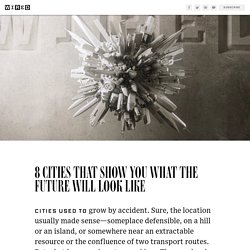
During the ’90s, drug gangs and guerrilla fighters controlled the narrow streets. As the violence waned and people started venturing out, they came up against another challenge: It was really hard to get anywhere. To knit together the fractured city, then-mayor Luis Pérez proposed a novel solution: cable cars. Rather than having to pick their way down perilous hillsides, people could hop in a gondola and soar to a metro station.
“The genius of the Metrocable is that it actually serves the poor and integrates them into the city, gives them access to jobs and other opportunities,” says Julio Dávila, a Colombian urban planner at University College London. Combining Libraries and Parks into Safe Spaces for All. 7 principles for building better cities. How Analyzing Plant Data Helps Vertical Farmers Have Control Over Plants. Alex Steffen: The shareable future of cities. Floating cities of the future. 3D-Printed Home Can Be Constructed For Under $4,000. Building Asia’s cities of the future. How one Asian developer is using planning and technology to make cities work for people.
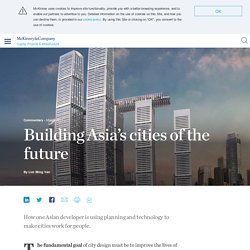
The fundamental goal of city design must be to improve the lives of people. That means the creation of fulfilling, enriching, and sustainable ways for residents to live, work, and play. Today, almost half of Asia’s population lives in cities. By 2050, the United Nations projects almost two-thirds of the world’s population will live in cities, as more rural dwellers migrate to urban areas. Rapid urbanization puts more pressure on land, making it important for each square meter to be used effectively. The modern, efficient cities of the future, then, will connect transportation hubs with quality retail, hospitality, commercial, and residential spaces.
CapitaLand’s Raffles City developments are an example of this thinking. Advances in digital technology will play an important role in Asia’s urban future. Meet 'the Tulip,' London's newest skyscraper - CNN Style. Written by Jack Guy, CNNLondon First there was the Gherkin, then the Walkie-Talkie and the Cheese Grater.

Now, meet the Tulip: London's new skyscraper design with a playful name and ambitious plans. On Monday British architects Foster + Partners revealed designs for a 305-meter (1,000-feet) tower that will become the second-tallest building in the British capital. Subject to approval, work on the building could begin by 2020 and finish in 2025. The Tulip will stand next door to 30 St Mary Axe, better known as the Gherkin, which was also designed by Foster + Partners.
Instead of hosting office or commercial space, however, the new structure will become a cultural and educational resource, according to the architects. Infrastructure for the evolution of urban mobility. Self-driving vehicles, ride-hailing services, and other technologies are transforming urban mobility.

To capture the benefits of the shift, cities will need sound infrastructure plans and investments. The way that people get around cities is changing dramatically. Technologies such as autonomous driving, electric powertrains, and mobile data connectivity are emerging alongside new transportation services, like ride-hailing and vehicle sharing, to form integrated mobility systems. Such systems will make it easier for city dwellers to use multiple modes of transportation, often on the same journey, and to get around town more cleanly, efficiently, and safely than ever. McKinsey estimates that in 50 metropolitan areas around the world, home to 500 million people, the benefits of integrated mobility systems, such as improved safety, could be worth up to $600 billion.
Vehicle electrification and distributed energy generation. Autonomous vehicles. Wooden skyscrapers could be the future for cities. What would happen if every human suddenly disappeared? - Dan Kwartler. Urban world: Meeting the demographic challenge in cities. Urban world: Meeting the demographic challenge in cities The days of easy growth in the world’s cities are over, and how they respond to demographic shifts will influence their prosperity.
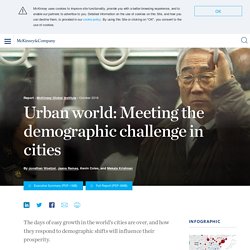
Cities have powered the world economy for centuries. Large cities generate about 75 percent of global GDP today and will generate 86 percent of worldwide GDP growth between 2015 and 2030. Population growth has been the crucial driver of cities’ GDP growth, accounting for 58 percent of it among large cities between 2000 and 2012. Rising per capita income contributed the other 42 percent. Overpopulation – The Human Explosion Explained. The architect transforming cities into 'vertical forests' - CNN Style.
Written by Oscar Holland, CNN CNN Style is the international digital news partner for the RIBA International Prize.
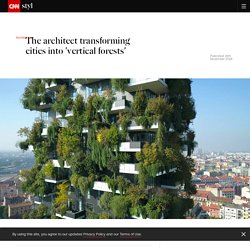
Over recent weeks we have been profiling the four finalists for the 2018 award. Architect Stefano Boeri has always been obsessed with trees. The Italian traces his fascination back to a novel he read as a child, "Il Barone Rampante" ("The Baron in the Trees"), in which a young boy climbs up into a world of trees and vows to never to return. "I think trees are individuals," Boeri said in a phone interview. Unsurprisingly, there is child-like wonder to the architect's best-known building, Il Bosco Verticale, or the Vertical Forest. Greenery is placed on balconies across the two buildings' facades. The project's two residential towers -- measuring 80 meters (262 feet) and 112 meters (367 feet) respectively -- play host to around 20,000 trees, shrubs and plants. How India is building a sustainable city - CNN Style. Written by Andrea Lo, CNN In south-east India, 217 square kilometers of farmland along the Krishna River are being transformed into a city billed as an urban utopia.
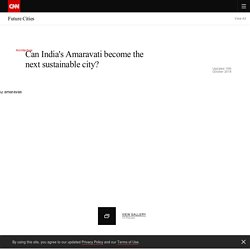
When complete, Amaravati will not only be the new capital of Andhra Pradesh state -- developers hope it will also be one of the most sustainable cities in the world. The Philippines' New Clark City will be green and disaster-resilient - CNN Style. In one of the most disaster-prone regions on the planet, a new city has been designed specifically to withstand natural calamities -- and it's being built using remnants of a major disaster.
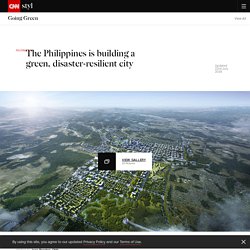
The Philippines has begun building a "back-up" city, from where government offices can still function should capital Manila succumb to a natural disaster such as an earthquake. The proposed metropolis, located 100 kilometers north of Manila, is called New Clark City. With plans to cover 9,450 hectares, it will be bigger than Manhattan and could accommodate as many as 1.2 million people. As well as being able to withstand typhoons, flooding, and earthquakes -- inevitable parts of life for a country located on the Pacific Ring of Fire, an area of intense seismic and volcanic activity -- the city aims to be pollution-free.
But how does it intend to achieve such a lofty goal? "When we build this city, we are building for people, we're not building for cars. Overcoming Mother Nature. Full speed ahead: How the driverless car could transform cities. Self-driving cars are not just about a hands-free driving experience.

Their emergence points to an urban transformation that will change the way people navigate, access information, and interact with one another. Just like Ford’s Model T, which debuted in 1908, today’s automobiles have four tires, a steering wheel, and seats. How Sou Fujimoto blends architecture with nature - CNN Style. Great architects, it seems, do not retire young.

Frank Lloyd Wright and Louis Kahn were both still working when they died at 91 and 73 respectively, and many of the legends working today -- the Frank Gehrys, Norman Fosters and Renzo Pianos of the world -- are pushing 90, and show no signs of slowing down. So it's surprising to hear that, at just 46, Sou Fujimoto is already is thinking hard about his legacy. Netherlands to host small community of 3D-printed houses - CNN Style. Written by Gianluca Mezzofiore, CNN Living in a community of 3D-printed homes will soon be reality in the Dutch city of Eindhoven. In what is considered a world first, a single-floor, three-room house made of 3D-printed concrete will be ready for occupation in 2019. City of Tomorrow. About this project The city of tomorrow might already be here.
Right now, 21st century challenges like greenhouse gases, crime and high energy costs — are being met worldwide with real innovation. In the coming years communities will grow at an amazing pace. The United Nations predicts by 2030, 60% of the world will live in cities. Demand for clean air, water, energy — and convenience — will skyrocket. Along with emerging innovations, increased connectivity via the Internet and smart devices promises to help solve many of these threats. Imagine turning the ocean into drinking water, ending traffic jams, making policing smarter and creating buildings with zero carbon footprints. The conversation is happening now at #CityofTomorrow on @CNN and Futuristic buildings Some buildings — even though they may be old — have very futuristic-looking designs.
The Most Advanced Civilization In The Universe. La population mondiale en 2050. How Far Can We Go? Limits of Humanity. Does time exist? - Andrew Zimmerman Jones. The Fermi Paradox II — Solutions and Ideas – Where Are All The Aliens? Marc Goodman: A vision of crimes in the future. 5 Future Predictions For The Human Race. Overpopulation – The Human Explosion Explained. This computer will grow your food in the future. Forget Shopping. Soon You'll Download Your New Clothes. Marc Kushner: Why the buildings of the future will be shaped by ... you. Imagining the Future: The Transformation of Humanity. What a driverless world could look like. What Will Happen in the Next 1000 Years? Population pyramids: Powerful predictors of the future - Kim Preshoff.
Why the rise of the robots won’t mean the end of work. Hanna Rosin: New data on the rise of women. Anab Jain: Why we need to imagine different futures. Dayo Ogunyemi: Visions of Africa's future, from African filmmakers. Genetic Engineering Will Change Everything Forever – CRISPR. Chatbot : dans la tête des robots virtuels - FUTURE - ARTE. The thrilling potential for off-grid solar energy. Fusion Energy Explained – Future or Failure. The Future of Virtual Reality. Quantum Computing Expert Explains One Concept in 5 Levels of Difficulty.
Military robots and the future of war-TED Talks. The Future of Flying Robots.